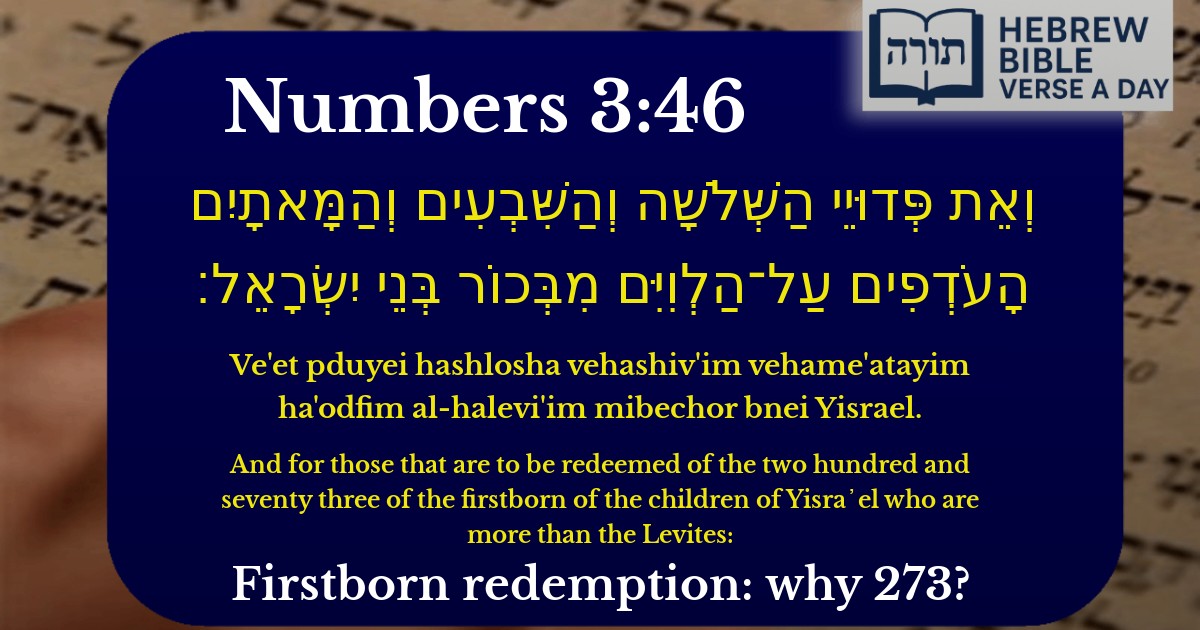Frequently Asked Questions
Q: What does Numbers 3:46 mean?
A: Numbers 3:46 discusses the redemption process for the 273 firstborn Israelites who exceeded the number of Levites. Since the Levites were chosen to serve in the Mishkan (Tabernacle) in place of the firstborn, the extra firstborns needed to be redeemed with money (five shekels each) as commanded in the Torah (Numbers 3:47). This teaches the importance of substitution and redemption in Jewish tradition.
Q: Why was there a need to redeem the firstborn in Numbers 3:46?
A: Originally, the firstborn Israelites were meant to serve in the Mishkan. However, after the sin of the Golden Calf, the Levites were chosen instead (Rashi on Numbers 3:12). Since there were more firstborns than Levites, the extra 273 firstborns had to be redeemed with money to fulfill their original sanctity.
Q: How does the concept of redemption in Numbers 3:46 apply today?
A: Today, the mitzvah of Pidyon HaBen (Redemption of the Firstborn) still applies to Jewish firstborn males (excluding those from Kohanim or Levites). A father redeems his son by giving five silver coins to a Kohen, continuing the tradition based on this verse (Rambam, Hilchot Bikkurim 11:1).
Q: Why were the Levites counted separately in Numbers 3:46?
A: The Levites were counted separately because they were chosen to serve in the Mishkan instead of the firstborn Israelites (Numbers 3:12). This counting ensured that every firstborn had either a Levite substitute or was redeemed with money, maintaining the sanctity of the firstborn.
Q: What is the significance of the number 273 in Numbers 3:46?
A: The number 273 represents the extra firstborn Israelites who could not be matched with Levites. These had to be redeemed with five shekels each (Numbers 3:47). The Midrash (Bamidbar Rabbah 4:4) highlights how this teaches precision in fulfilling mitzvot and the importance of every individual's role in Jewish service.


Context of the Verse
This verse appears in Bamidbar (Numbers) 3:46, within the context of the census of the Levites and the redemption of the firstborn of Israel. The Torah commands that the Levites serve in the Mishkan (Tabernacle) in place of the firstborn, who were originally designated for this role after being sanctified during the Exodus from Egypt. However, since there were more firstborn Israelites than Levites, a redemption process was necessary for the surplus firstborn.
Explanation of the Numbers
The verse specifies that there were 273 firstborn Israelites beyond the number of Levites who needed to be redeemed. Rashi (Bamidbar 3:46) explains that this calculation was derived by subtracting the 22,000 Levites from the 22,273 firstborn Israelites. The extra 273 firstborn required redemption through a payment of five shekels each, as prescribed in the Torah (Bamidbar 3:47).
The Redemption Process
The Rambam (Hilchot Bikkurim 11:1-2) elaborates on the mitzvah of pidyon haben (redemption of the firstborn), which applies to firstborn sons who are not from the tribe of Levi or the descendants of Kohanim. The 273 firstborn in this verse represent those who could not be substituted by Levites and thus needed monetary redemption.
Broader Implications
The Talmud (Bechorot 5a) discusses the significance of this exchange, emphasizing that the Levites' service in the Mishkan was a merit that replaced the firstborn's initial sanctity. This teaches the principle that divine service requires both sanctity and dedication, as the Levites demonstrated through their commitment.
Additionally, the Chizkuni (Bamidbar 3:46) notes that the precise accounting of the firstborn underscores the Torah's emphasis on fairness and exactness in fulfilling mitzvot, ensuring that no firstborn was left unredeemed.